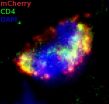New technique yields fast results in drug, biomedical testing
2014-10-09
(Press-News.org) WEST LAFAYETTE, Ind. – A new technique makes it possible to quickly detect the presence of drugs or to monitor certain medical conditions using only a single drop of blood or urine, representing a potential tool for clinicians and law enforcement.
The technique works by extracting minute quantities of target molecules contained in specimens of blood, urine or other biological fluids, and then testing the sample with a mass spectrometer.
Testing carried out with the technology takes minutes, whereas conventional laboratory methods take hours or days to yield results and require a complex sequence of steps, said Zheng Ouyang (pronounced Jung O-Yong), an associate professor in Purdue's Weldon School of Biomedical Engineering.
"We've converted a series of operations into a single extraction process requiring only a pinprick's worth of blood," he said.
The method, called "slug flow microextraction," could be used to detect steroids in urine for drug screening in professional sports and might be combined with a miniature mass spectrometer also being commercialized. The combined technologies could bring a new class of compact instruments for medicine and research, Ouyang said.
Findings are detailed in a paper appearing online Oct. 5 in the research journal Angewandte Chemie International Edition. The paper was authored by graduate student Yue Ren, undergraduate student Morgan N. McLuckey, former postdoctoral research associate Jiangjiang Liu and Ouyang.
The researchers demonstrated the technique, using it to perform therapeutic-drug monitoring, which has potential applications in drug development and personalized therapy; to monitor enzyme function, as demonstrated for acetylcholinesterase, which is directly related to the symptoms and therapy for Alzheimer's disease; to detect steroids, yielding results in one minute; and to test for illicit drugs.
"In the future, for example, parents might be able to test their children's urine for drugs with a simple cartridge they would take to the corner drug store, where a desktop mass spectrometer would provide results in a few minutes," Ouyang said.
The technique involves drawing a specimen into a glass capillary that also contains the organic solvent ethyl acetate.
Like oil and water, the two fluids are immiscible, and an interface is formed between the specimen and the solvent. Gently rocking the capillary back and forth several times causes small amounts of target molecules in the biological sample to cross this interface into the solvent side without mixing the two fluids.
"You don't want to mix these two, you want to extract only the biomarkers you are looking for and leave the junk behind because mass spectrometry is very sensitive to impurities," Ouyang said.
Then the solvent containing the biomarkers is subjected to a high-voltage current, ionizing the sample so that it can be analyzed with mass spectrometry.
Other researchers have used microextraction for different applications.
"I think this is the first time it has been applied to a biological sample for mass spectrometry," Ouyang said. "You just use a pinprick of blood, and the analysis is completed in minutes."
When combined with the miniature mass spectrometer also developed at Purdue the method represents a mobile system for medical professionals, researchers and law enforcement.
Mass spectrometry works by turning molecules into ions, or electrically charged versions of themselves, inside the instrument's vacuum chamber. Once ionized, the molecules can be more easily manipulated, detected and analyzed based on their masses. The new approach uses a method called nanoESI – or nano electrospray ionization - in which the ionization step is performed in the air or directly on surfaces and does not require a vacuum chamber.
Although the research was conducted using a conventional laboratory mass spectrometer, the same nanoESI operation could be carried out with the new miniature mass spectrometer. Whereas conventional mass spectrometers are bulky instruments that weigh more than 300 pounds, Purdue researchers have recently completed their latest version of the miniature mass spectrometer, the Mini 12, which weighs 40 pounds, is 12.5 inches wide and 16 inches high.
"The sampling ionization technologies like slug flow microextraction could make the miniature mass spectrometers perform the actual testing without requiring other equipment for sample treatment," Ouyang said. "This will bring a new class of compact medical instruments."
The research has been funded by the National Institutes of Health.
The work to develop the miniature mass spectrometer has been supported by the National Institutes of Health and National Science Foundation and is led by Ouyang and R. Graham Cooks, the Henry Bohn Hass Distinguished Professor of Chemistry in Purdue's College of Science.
U.S. patent applications have been filed for the microextraction and miniature mass spectrometry. The technologies may be commercialized through a new company formed after partnership agreements were signed in 2013 by Purdue and Tsinghua University.
"The overall goal is to use this technology for developing disposable sample cartridges to work with our mini mass spectrometry system in clinical and especially the point-of-care applications in a doctor's office," Ouyang said.
INFORMATION:
Writer: Emil Venere, 765-494-4709, venere@purdue.edu
Source: Zheng Ouyang, 765-494-2214, ouyang@purdue.edu
IMAGE CAPTION:
A new technique called slug flow microextraction makes it possible to quickly detect the presence of drugs or to monitor certain medical conditions using only a single drop of blood or urine. The technique involves drawing a specimen into a glass capillary that also contains an organic solvent and rocking the capillary back and forth several times to extract target molecules from the biological sample into the solvent. (Purdue University image/Weldon School of Biomedical Engineering)
A publication-quality photo is available at http://news.uns.purdue.edu/images/2014/ouyang-microextraction.jpg
ABSTRACT
Direct Mass Spectrometry Analysis of Biofluid Samples Using Slug Flow Microextraction NanoESI**
Yue Ren, Morgan N. McLuckey, Jiangjiang Liu and Zheng Ouyang*
* Weldon School of Biomedical Engineering, Purdue University
** This research was supported by Nation Institutes of Health
Direct mass spectrometry (MS) analysis of bioluids with simple procedures, such as using the ambient ionization, represents a key step for translation of MS technologies to the clinical and point-of-care applications. The current study reports the development of a single-step method using slug flow micro extraction and nanoESI (electrospray ionization) for MS analysis of organic compounds in blood and urine. High sensitivity and quantitation precision have been achieved for analysis of therapeutic and illicit drugs in 5 μL samples. Real-time chemical derivatization has been incorporated for analyzing anabolic steroids. The monitoring of enzymatic functions of wet blood has also been demonstrate with the cholinesterase. The reported development encourages the future design of highly functioning but simple devices, in replacement of traditional complex lab procedures for MS analysis of biological samples.
[Attachments] See images for this press release:

ELSE PRESS RELEASES FROM THIS DATE:
2014-10-09
SAN FRANCISCO -- The information that interprets the genetic code in a new embryo differs depending on whether it comes from the father or mother, researchers at San Francisco State University have found.
The research, detailed in an article published today in the journal PLOS Genetics, sheds light on the multilayered process of how a sperm and egg pass along information needed for successful reproduction. Though one layer is the DNA code that is transferred, the new study identifies information not encoded by DNA, a so-called "epigenetic" layer of information that helps ...
2014-10-09
Most women are infected with HIV through vaginal intercourse, and without effective vaccines or microbicides, women who cannot negotiate condom use by their partners remain vulnerable. How exactly the virus establishes infection in the female reproductive tract (FRT) remains poorly understood. A study published on October 9th in PLOS Pathogens reports surprising results from a study of HIV transmission in the FRT of rhesus macaques.
Most studies of HIV transmission after vaginal exposure to date have been done in rhesus macaques and focused on the cervix, the lower part ...
2014-10-09
VIDEO:
This video explains research done to understand the motion used by sidewinder snakes to climb sandy slopes and to apply that motion to a snake-like robot. Researchers from Georgia Tech,...
Click here for more information.
The amazing ability of sidewinder snakes to quickly climb sandy slopes was once something biologists only vaguely understood and roboticists only dreamed of replicating. By studying the snakes in a unique bed of inclined sand and using a snake-like robot ...
2014-10-09
CANCER RESEARCH UK scientists have discovered that lung cancers can lie dormant for over 20 years before suddenly turning into an aggressive form of the disease, according to a study published in Science* today (Thursday).
The team studied lung cancers from seven patients – including smokers, ex-smokers and never smokers. They found that after the first genetic mistakes that cause the cancer, it can exist undetected for many years until new, additional, faults trigger rapid growth of the disease.
During this expansion there is a surge of different genetic faults ...
2014-10-09
When young mice with the rodent equivalent of a rare autism spectrum disorder (ASD), called Rett syndrome, were fed a diet supplemented with the synthetic oil triheptanoin, they lived longer than mice on regular diets. Importantly, their physical and behavioral symptoms were also less severe after being on the diet, according to results of new research from The Johns Hopkins University.
Researchers involved in the study think that triheptanoin improved the functioning of mitochondria, energy factories common to all cells. Since mitochondrial defects are seen in other ...
2014-10-09
During their approximately 100-day lifespan in the bloodstream, red blood cells lose membrane surface area, volume, and hemoglobin content. A study publishing this week in PLOS Computational Biology finds that of these three changes, only the observed surface-area loss can be explained by RBCs shedding small hemoglobin-containing vesicles budding off their cells' membrane.
Red blood cell concentration, mean volume, and hemoglobin content are routinely measured in the complete blood count, a fundamental clinical test essential to the screening, diagnosis, and management ...
2014-10-09
As birth rates decline in countries that include parts of Europe and East Asia, threatening the economic slowdown associated with aging populations, a global study from the University of California, Berkeley, and the East-West Center in Hawaii suggests that in much of the world, it actually pays to have fewer children. The results challenge previous assumptions about population growth.
Researchers in 40 countries correlated birth rates with economic data and concluded that a moderately low birth rate – a little below two children per woman – can actually ...
2014-10-09
A team of scientists including a University of Colorado Boulder professor used NASA's Hubble Space Telescope to make the most detailed global map yet of the glow from a giant, oddball planet orbiting another star, an object twice as massive as Jupiter and hot enough to melt steel.
The Hubble observations show that the planet, called WASP-43b, is no place to call home. It's a world of extremes, where winds howl at the speed of sound from a 3,000-degree-Fahrenheit dayside to a pitch-black nightside when temperatures plunge to a relatively cool 1,000 degrees Fahrenheit, ...
2014-10-09
Using X-rays and neutron beams, a team of researchers from the University of California, San Diego School of Medicine, University of Utah and Oak Ridge National Laboratory have teased out new information about Protein Kinase A (PKA), a ubiquitous master switch that helps regulate fundamental cellular functions like energy consumption and interactions with hormones, neurotransmitters and drugs.
"Mutations in PKA can lead to a variety of different human diseases, including cancers, metabolic and cardiovascular diseases and diseases involving the brain and nervous system," ...
2014-10-09
Known cancer-driving genomic aberrations in localized lung cancer appear to be so consistently present across tumors that a single biopsy of one region of the tumor is likely to identify most of them, according to a paper published today in Science.
The study led by scientists at The University of Texas MD Anderson Cancer Center addresses the challenge of what scientists call genomic heterogeneity, the presence of many different variations that drive tumor formation, growth and progression, and likely complicate the choice and potential efficacy of therapy.
A landmark ...
LAST 30 PRESS RELEASES:
[Press-News.org] New technique yields fast results in drug, biomedical testing



